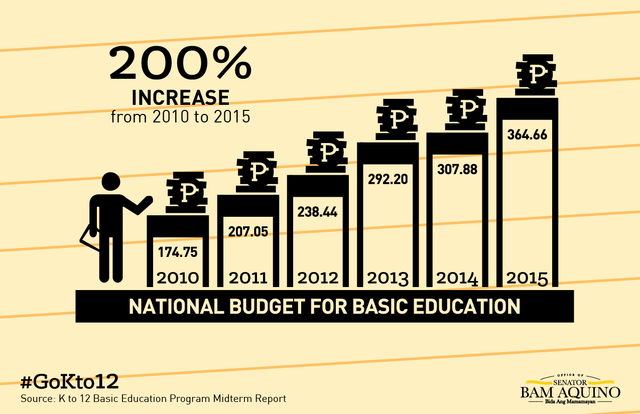Bam ready for challenges as he takes helm of education committee
As we welcome a new school year, we are reminded of our need to constantly improve the quality of education for Filipinos across the country.
Aligned with this goal is the Enhanced Basic Education Act of 2013 or Republic Act No. 10533, which was signed into law on May 15, 2013 and resulted in the implementation of the K-12 Basic Education Program.
The last country in Asia with a 10-year pre-university cycle, the Philippines is one of only three, along with Angola and Djibouti, stuck in a 10-year basic education system.
Far from being a quick fix to our laggard status, the K to 12 program was carefully studied and designed by both private and public education stakeholders based on research from other countries and our own local successes and failures in education.
Many would agree that actualizing the K-12 system in the Philippines would result in more young Filipinos equipped with the necessary knowledge, skills and attitudes to enter the workforce.
And even though there are those that disagree and question whether or not we should transition to a K to 12 education system, this article is not about that.
The challenge we face now, in my view, is not whether we should or shouldn’t, but whether we can or can’t.
Are we ready to bring the K to 12 vision of progressive and transformative education to reality? Are we ready with classrooms and infrastructure to accept 2 more grade levels? Are we ready with the curriculum to move our education system to the world-class standard we have long been aspiring for?
To be fair to the Department of Education (DepEd), they have made progress in terms of infrastructure and curriculum development.
The backlog of 66,800 classrooms in 2010 was addressed with DepEd building over86,478 classrooms from 2010 to 2014 with plans to build over 40,000 more this year.
The shortage of 145,827 teachers in 2010 was addressed with DepEd hiring over 128,000 teachers from 2010 to 2014 with over 39,000 more to be hired this year.

Increased budget
But what about the 25,000 or so teaching and non-teaching staff that will be displaced once the K-12 program is completely implemented? DepEd reports that there will be at least 30,000 teaching positions in public senior high schools open for hiring, not to mention the need for principals and other non-teaching staff.
A P12-billion Tertiary Education Transition fund is also in the pipeline to offer grants, scholarships, and financial assistance to displaced employees so they may be qualified to continue working in the field of education.
With more classrooms and more teachers, congestion in our public schools has gone down and this is evidenced by the big reduction in schools that employ a two, three, even four-shift system. When in 2011, 21.24% of our elementary schools resorted to shifting, only 3% utilized a shifting system in 2014.

(Writer’s Note: Most of the schools that fall under the 3% are located in the National Capital Region (NCR) where DepEd has no more space or land to expand schools and build new facilities.)
Looking at these figures, we can clearly say that tremendous improvements have been made. But, to be frank, not a lot of our citizens know that DepEd has hit these numbers in the last 5 years. In fact, when I go around schools, students still ask me why the government keeps cutting the budget for education.
In truth, we’ve actually increased the budget by over 200% from 2010 to 2015, from P174.75 billion to P364.66 billion.

These gains we have had in the past years put into perpective the ability of DepEd and our education stakeholders to make necessary preparations and improvements in the condition of education across the Philippines. These small victories should give us reason to believe in our ability to overcome challenges in improving the quality of Philippine education, or at least dispel any doubts about our capability to perform.
But the truth of the matter is, even with these numbers facing us, there is so little trust in the government’s ability to implement major reforms. And from the feedback of some of our countrymen, a number of Filipinos don’t believe we can get this done by 2017.
Definitely, there are legitimate concerns that demand solutions. Definitely, a lot of work still needs to be done. Definitely, there will be unforeseen challenges along the way. It will definitely not be easy.
But the good news is, we still have time. There is an entire year before the full nationwide implementation of the K-12 Program and the performance of DepEd thus far gives us enough reason to trust that we can get this done together.
Now is the time for our communities to get involved. Now is the time for the private sector to offer their expertise and resources. Now is the time for all of us to get behind a program that will empower our youth with knowledge and skills that can propel them and their families to live better, more comfortable, and more meaningful lives.
Now is not the time to hit the brakes on a national reform we desperately need and have been working towards for the past years. Now is not the time to prematurely declare that we cannot make it happen. We have a year to implement this major education program and DepEd has asked for our help (For concerns and suggestions, email action@deped.gov.ph or call (02)636.1663 / (02)633.1942.)
For those who believe that we need to improve our educational system in the Philippines, this is our chance. We must not miss another opportunity to raise the level of our education to one that is world class. Let us support DepEd in creating a better, more robust, more effective, and more progressive education system for our young Filipinos through the K to 12 Basic Education Program.
First Published on Rappler.com
Recent Comments